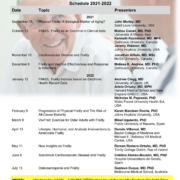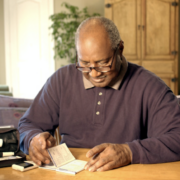Family Caregiving: An Essential Resource for Older Adults
It is estimated that somewhere between 18 million (Schulz & Eden, 2016) and 53 million (AARP, 2020) Americans provide care to an older adult with a disability who needs some type of help with basic living needs. This care can include help with grooming, bathing, or dressing; assistance with mobility or preparing meals, or help with managing finances or medical appointments. Most older adults with dementia, limited physical capabilities, or major sensory problems depend on family members or close friends for this kind help on a regular basis.
Substantial research over the past 30+ years has examined the health and well-being of family caregivers. Many of these studies have been inspired by a stress process model of caregiving (Pearlin et al., 1990), which emphasizes that caregiving can lead to both primary stressors that are directly associated with care delivery and secondary stressors that are indirect consequences of caregiving, such as reduced opportunities for leisure activities. This model is frequently invoked as part of an advisory narrative – that the stress of caregiving can be substantial and can lead to health problems for the caregivers (Pinquart & Sörensen, 2003).
More recently, however, researchers have countered this stress process narrative with alternative perspectives that emphasize the potential health benefits of prosocial helping behaviors. Research on volunteerism and social support has shown that people who help others are generally healthier themselves (Brown and Brown, 2015; Okun et al., 2013), remaining more active in their lives and finding purpose in the positive influences they have on others. Perhaps caregiving can also have this beneficial effect, much like volunteering within one’s own family or social circle.
These competing narratives may both be true to some extent. Most caregivers do report positive benefits associated with their caregiving experiences (Roth et al., 2015), but a small minority of caregivers also find the stress of caregiving to be quite high. A prominent early study concluded that the stress of caregiving may even be associated with higher mortality rates for caregivers (Schulz and Beach, 1999), but at least eight subsequent studies, with larger samples and longer follow-up periods, have found just the opposite pattern — that caregivers live longer or have lower mortality rates than several non-caregiving comparison samples (Roth et al., 2015; Mehri et al., 2021). In one follow-up study, caregivers were found to have higher rates of depressive symptoms than non-caregivers, but lived longer anyway (Roth et al., 2018), suggesting the caregivers benefitted from a resilience to stress due to their prosocial helping activities, similar to resilience benefits of older adults who are active in volunteer organizations.
Caregiving, therefore, can be stressful, but that stress is usually not dangerous or leading to life-threatening illnesses. Caregiving, like parenting, is a normal and usually healthy relationship within families – sometimes stressful, but more often rewarding and fulfilling, and something that should be encouraged. More evidence is needed to understand how frailty might impact caregiving burden (Ringer et al., 2017), but even for highly vulnerable “frail” persons, the benefits of providing support may likely outweigh any detrimental effects.
The real threat to the caregiving resource for older adults in the years to come is a looming shortage in number of traditional family caregivers. In the past, older adults have typically depended on spouses or adult children for this type of care, but, because marriage rates and birth rates have steadily declined over the past several decades, there are now fewer spouses and fewer adult children available to take on these roles. Caregiving networks, organized through faith-based groups and other community organizations, may be part of the solution. We should all start looking around for family members and friends whom we can help, even if they might be outside of our own traditional nuclear families. If anything, the research convincingly shows that this type of helping behavior is not only good for those who are receiving care, but also for the helper as well.





